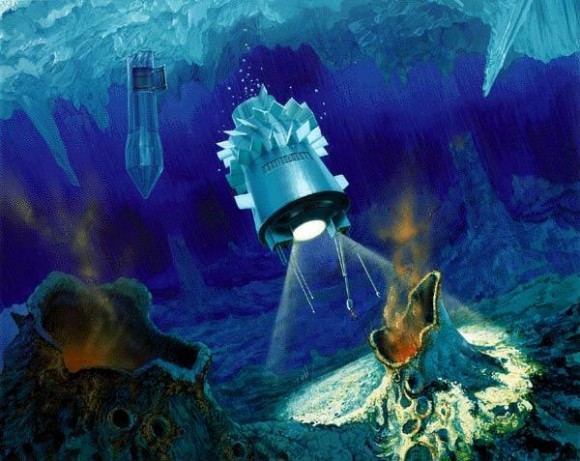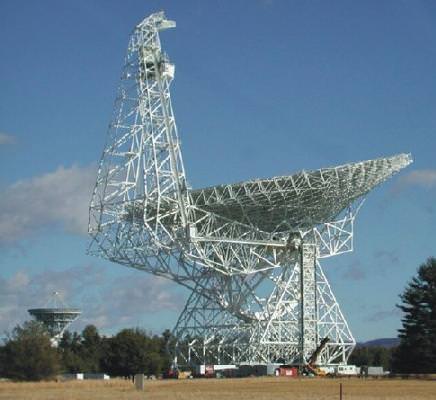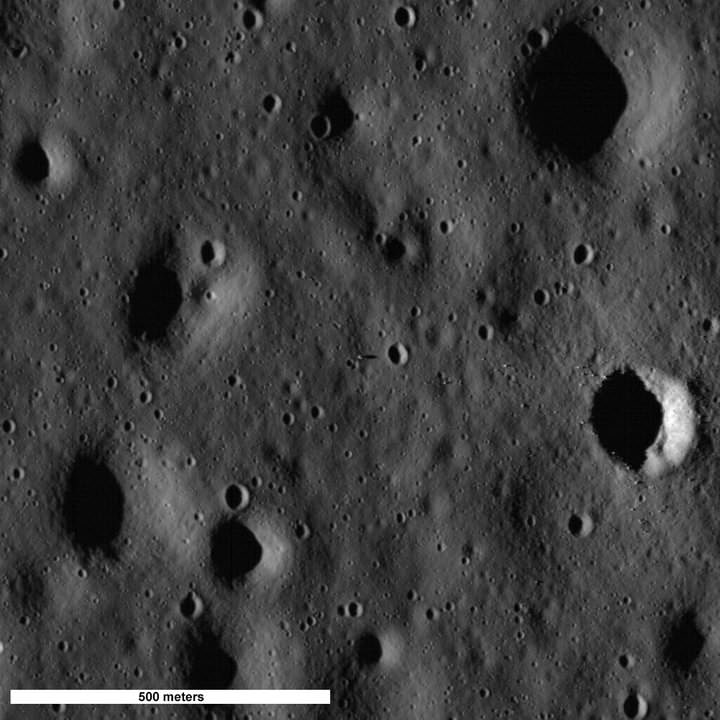Even though there were no wheelies or skid marks, it was an exciting day for the teams working on the next Mars rover. The Mars Curiosity rover (or the Mars Science Laboratory) took its first short drive in the JPL clean room where it is being built. This video was captured from live broadcast on July 23, 2010. Cheers and commentary provided by mission team members who watched the event from a viewing gallery above the clean room floor. In this clip the rover drives backward for the first time.
Astronomy Without A Telescope – Our Ageing Universe
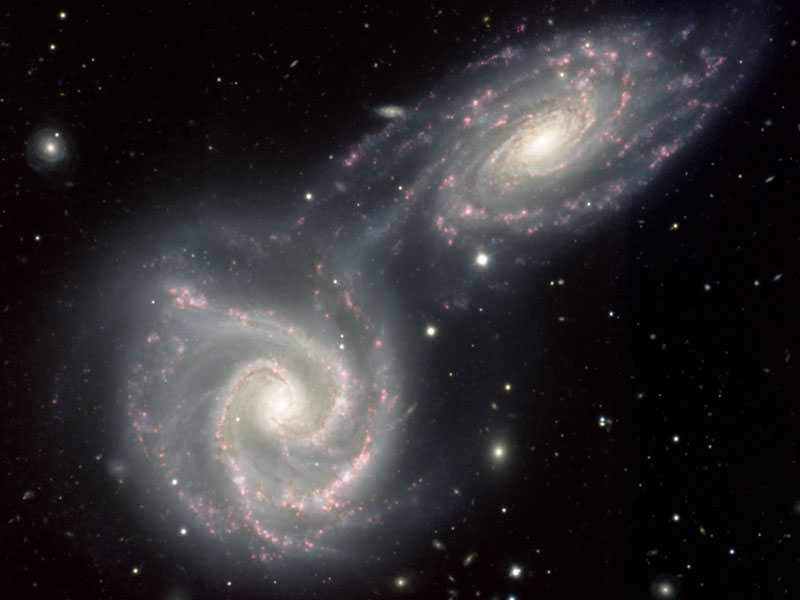
[/caption]
It all started so full of promise. All at once, our universe burst upon the scene, but much of that initial burst quickly dissipated into background neutrinos and photons – and ever since, pretty much everything our universe has ever done has just dissipated more energy. So, despite the occasional enthusiastic outburst of supernovae and other celestial extravagances, it’s becoming increasingly apparent that our universe is getting on a bit.
The second law of thermodynamics (the one about entropy) demands that everything goes to pot over time – since anything that happens is an opportunity for energy to be dissipated.
The universe is full of energy and should always remain so, but that energy can only make something interesting happen if there is a degree of thermal disequilibrium. For example, if you take an egg out of the refrigerator and drop it in boiling water, it cooks. A useful and worthwhile activity, even if not a very efficient one – since lots of heat from the stove just dissipates into the kitchen, rather than being retained for the cooking of more eggs.
But, on the other hand, if you drop an already cooked, already heated egg into the same boiling water… well, what’s the point? No useful work is done, nothing of note really happens.
This is roughly the idea behind increasing entropy. Everything of note that happens in the universe involves a transfer of energy and at each such transfer some energy is lost from that system. So, following the second law to its logical conclusion, you eventually end up with a universe in thermal equilibrium with itself. At that point, there are no disequilibrium gradients left to drive energy transfer – or to cook eggs. Essentially, nothing else of note will ever happen again – a state known as heat death.
It’s true that the early universe was initially in thermal equilibrium, but there was also lots of gravitational potential energy. So, matter (both light and dark) ‘clumped’ – creating lots of thermal disequilibrium – and from there all sorts of interesting things were able to happen. But gravity’s ability to contribute useful work to the universe also has its limits.
In a static universe the end point of all this clumping is a collection of black holes – considered to be objects in a state of high entropy, since whatever they contain no longer engages in energy transfer. It just sits there – and, apart from some whispers of Hawking radiation, will just keep sitting there until eventually (in a googol or so years) the black holes evaporate.
The contents of an expanding universe may never achieve a state of maximum entropy since the expansion itself increases the value of maximum entropy for that universe – but you still end up with not much more than a collection of isolated and ageing white dwarfs – which eventually fizzle out and evaporate themselves.

It’s possible to estimate the current entropy of our universe by tallying up its various components – which have varying levels of entropy density. At the top of the scale are black holes – and at the bottom are luminous stars. These stars appear to be locally enthalpic – where for example, the Sun heats the Earth enabling all sorts of interesting things to happen here. But it’s a time-limited process and what the Sun mostly does is to radiate energy away into empty space.
Egan and Lineweaver have recently re-calculated the current entropy of the observable universe – and gained a value that is an order of magnitude higher than previous estimates (albeit we are talking 1×10104 – instead of 1×10103). This is largely the result of incorporating the entropy contributed by recently recognized supermassive black holes – where the entropy of a black hole is proportional to its size.
So this suggests our universe is a bit further down the track towards heat death than we had previously thought. Enjoy it while you can.
Further reading: Egan, C.A. and Lineweaver, C.H. (2010) A Larger Estimate of the Entropy of the Universe http://arxiv.org/abs/0909.3983
Most Massive Star Discovered: Over 300 Suns at Birth!
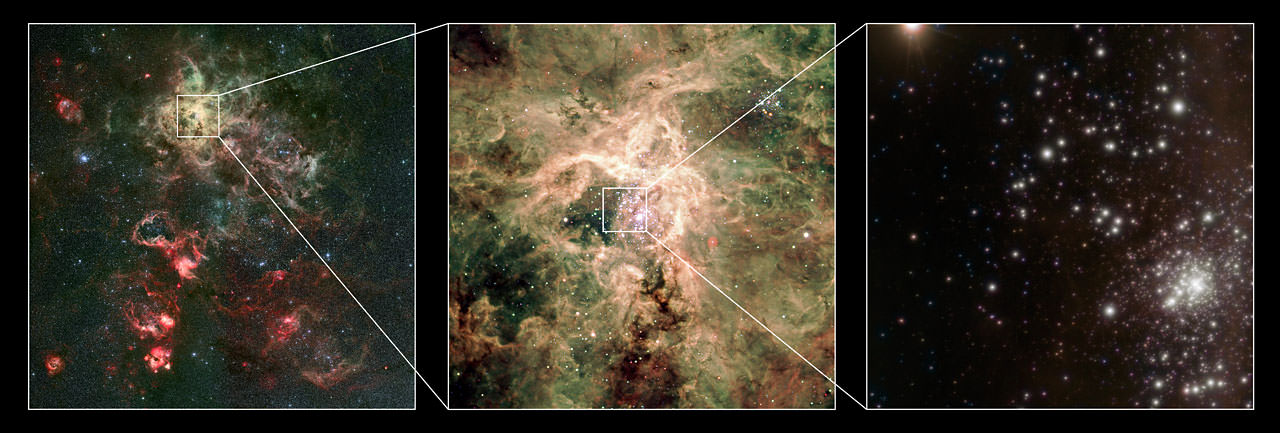
[/caption]
Often, writing about astronomy tends to mirror the job of those writing for the Guinness Book of World Records – just when you think a record is practically unbeatable, somebody else appears to show up the previous record-holder. This is surely the case with the stellar heavyweight (er, “heavymass”) R 136a1, which has been shown by data taken using the European Southern Observatory’s Very Large Telescope and the Hubble Space Telescope to tip the stellar scales at 265 times the mass of our Sun. What’s even more impressive is that R 136a1 has lost mass over the course of its lifetime, and likely was about 320 solar masses at birth. That deserves a “Yikes!”
R 136a1 lies in a cluster of young, massive stars with hot surface temperatures that is located inside the Tarantula Nebula. The Tarantula Nebula is nested inside the Large Magellanic Cloud, one of the Milky Way’s closest galactic neighbors, 165,000 light-years away. The cluster is called RMC 136a (or more commonly referred to as R136), and in addition to the whopper that is R 136a1, there are three other stars with masses at birth in the 150 solar mass range.
Extremely massive stars like R 136a1 were previously thought to be unable to form, posing a challenge to stellar physicists as to just how this behemoth came about. It’s possible that it formed by itself in the relatively dense gas and dust of the R136 cluster, or that multiple smaller stars merged to create the larger star at some point early on in its lifetime.
If breaking the mass record weren’t enough, R136a1 also happens to be the most luminous star ever discovered, with an output of energy that is over 10 million times that of the Sun. If you want to learn more about how astronomers determine the mass and luminosity of stars, here is an excellent and thorough introduction to the subject.
To validate the models used in determining the mass and luminosity of the stars in R136, the team of astronomers led by Paul Crowther, Professor of Astrophysics at the University of Sheffield, used the VLT to examine NGC 3603, a closer stellar nursery. NGC 3603 is only 22,000 light years away, and two of the stars in that cluster are in a binary system, which allowed the team to measure their masses.
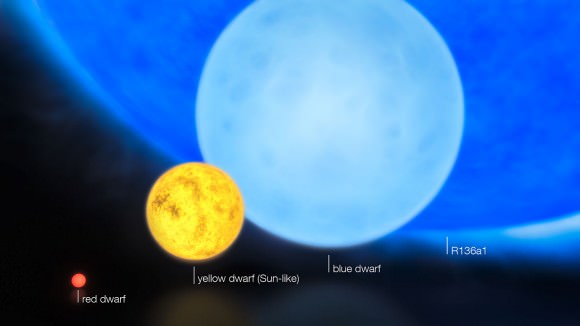
We are lucky to have observed this extremely massive star, as the rule for the most massive stars is, “Live fast, die young.” The more massive a star is, the faster it churns through the fuel that powers its increased luminosity. Our Sun, which has a medium amount of mass in relation to the two extremes, will last for around for about 10 billion years. Smaller, red dwarf stars can last trillions of years, while large stars on the scale of R 136a1 only glimmer in all of their brilliance for millions of years.
What will happen to R 136a1 at the end of its life? Stars with a mass of over 150 Suns ultimately explode in a light show of staggering proportions generated by what’s called a pair-instability supernova. For more on this phenomenon, check out this article from Universe Today from last year.
Source: ESO press release
A nod and a snarky wink to Genevieve Valentine
Europa Analog Deep-Sea Vents Discovered in the Caribbean
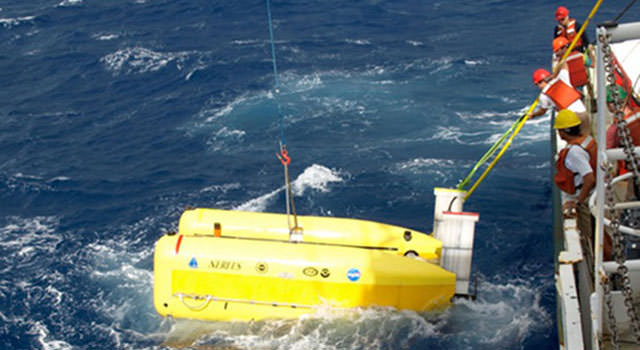
[/caption]
White sand, blue water, sunny skies, pina coladas. When you think of “extreme environments” I doubt the Caribbean is high on your list. But a team of scientists from Woods Hole Oceanographic institute and NASA’s Jet Propulsion Laboratory, exploring the 68-mile-long Mid-Cayman rise deep beneath the surface of the Caribbean, have discovered the deepest known hydrothermal vent in the world, along with two other distinct types of vents.
The mid-Cayman rise is a much smaller version of the mid-ocean ridge system, a chain of submarine mountains that encircles the globe. These ridges form in locations where tectonic plates are pulling apart, allowing mantle rocks to melt and emerge at the surface as lava. Seawater, percolating through the hot rocks at these spreading centers, is superheated and emerges at vents, bearing a rich bounty of dissolved nutrients to support thriving ecosystems that can live without any sunlight.
“This was probably the highest-risk expedition I have ever undertaken,” said chief scientist Chris German, a Woods Hole Oceanographic Institution geochemist who has pioneered the use of autonomous underwater vehicles to search for hydrothermal vent sites. “We know hydrothermal vents appear along ridges approximately every 100 kilometers [62 miles]. But this ridge crest is only 100 kilometers long, so we should only have expected to find evidence for one site at most. So finding evidence for three sites was quite unexpected – but then finding out that our data indicated that each site represents a different style of venting – one of every kind known, all in pretty much the same place – was extraordinarily cool.”
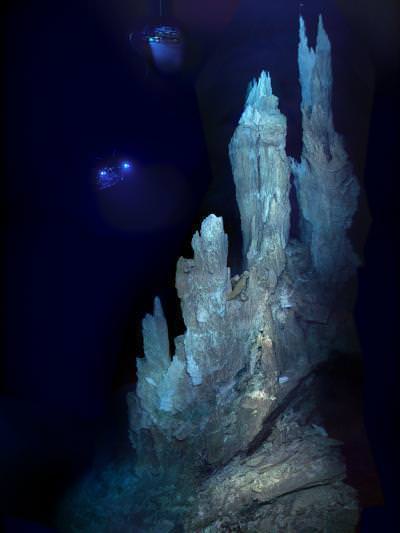
In addition to the deepest hydrothermal vent yet discovered, at a depth of 5,000 meters (16,400 feet), the team also found a shallower low-temperature vent. Only one other vent of this type has been discovered: the famous “Lost City” vent in the Atlantic.
“We were particularly excited to find compelling evidence for high-temperature venting at almost 5,000 meters depth,” said Julie Huber, a scientist in the Josephine Bay Paul Center at the Marine Biological Laboratory in Woods Hole. “We have absolutely zero microbial data from high-temperature vents at this depth.”
The ecosystems encrusting the deep sea vents on the mid-Cayman rise provide valuable clues to how life could arise and thrive elsewhere in the solar system. “Most life on Earth is sustained by food chains that begin with sunlight as their energy source. That’s not an option for possible life deep in the ocean of Jupiter’s icy moon Europa,” said JPL co-author Max Coleman.
With an airless sky, intense radiation, icy crust, and no pina coladas, the surface of Europa is about as different from the Caribbean as you can get. But deep on the sea floor, they may be remarkably similar.
“Organisms around the deep vents get energy from the chemicals in hydrothermal fluid, a scenario we think is similar to the seafloor of Europa,” Coleman said. “This work will help us understand what we might find when we search for life there.”
New Technique Could Track Down Dark Energy
[/caption]
From an NRAO press release:
Dark energy is the label scientists have given to what is causing the Universe to expand at an accelerating rate, and is believed to make up nearly three-fourths of the mass and energy of the Universe. While the acceleration was discovered in 1998, its cause remains unknown. Physicists have advanced competing theories to explain the acceleration, and believe the best way to test those theories is to precisely measure large-scale cosmic structures. A new technique developed for the Robert C. Byrd Green Bank Telescope (GBT) have given astronomers a new way to map large cosmic structures such as dark energy.
Sound waves in the matter-energy soup of the extremely early Universe are thought to have left detectable imprints on the large-scale distribution of galaxies in the Universe. The researchers developed a way to measure such imprints by observing the radio emission of hydrogen gas. Their technique, called intensity mapping, when applied to greater areas of the Universe, could reveal how such large-scale structure has changed over the last few billion years, giving insight into which theory of dark energy is the most accurate.
“Our project mapped hydrogen gas to greater cosmic distances than ever before, and shows that the techniques we developed can be used to map huge volumes of the Universe in three dimensions and to test the competing theories of dark energy,” said Tzu-Ching Chang, of the Academia Sinica in Taiwan and the University of Toronto.
To get their results, the researchers used the GBT to study a region of sky that previously had been surveyed in detail in visible light by the Keck II telescope in Hawaii. This optical survey used spectroscopy to map the locations of thousands of galaxies in three dimensions. With the GBT, instead of looking for hydrogen gas in these individual, distant galaxies — a daunting challenge beyond the technical capabilities of current instruments — the team used their intensity-mapping technique to accumulate the radio waves emitted by the hydrogen gas in large volumes of space including many galaxies.
“Since the early part of the 20th Century, astronomers have traced the expansion of the Universe by observing galaxies. Our new technique allows us to skip the galaxy-detection step and gather radio emissions from a thousand galaxies at a time, as well as all the dimly-glowing material between them,” said Jeffrey Peterson, of Carnegie Mellon University.
The astronomers also developed new techniques that removed both man-made radio interference and radio emission caused by more-nearby astronomical sources, leaving only the extremely faint radio waves coming from the very distant hydrogen gas. The result was a map of part of the “cosmic web” that correlated neatly with the structure shown by the earlier optical study. The team first proposed their intensity-mapping technique in 2008, and their GBT observations were the first test of the idea.
“These observations detected more hydrogen gas than all the previously-detected hydrogen in the Universe, and at distances ten times farther than any radio wave-emitting hydrogen seen before,” said Ue-Li Pen of the University of Toronto.
“This is a demonstration of an important technique that has great promise for future studies of the evolution of large-scale structure in the Universe,” said National Radio Astronomy Observatory Chief Scientist Chris Carilli, who was not part of the research team.
In addition to Chang, Peterson, and Pen, the research team included Kevin Bandura of Carnegie Mellon University. The scientists reported their work in the July 22 issue of the scientific journal Nature.
Comet Whacked Neptune 200 Years Ago
Researchers studying Neptune’s atmosphere found evidence that a comet may have hit the planet about two centuries ago. Was this a “cold-case” file re-opened, or did they discover a way to travel back in time to witness a long-ago event? To make the discovery, a team from the Max Planck Institute for Solar System Research actually used the Herschel Space Telescope’s PACS (Photodetector Array Camera and Spectrometer) instrument, along with what was learned from observations from when the Shoemaker-Levy 9 hit Jupiter sixteen years ago.
Continue reading “Comet Whacked Neptune 200 Years Ago”
First Quasar Gravitational Lens Discovered (w/video)
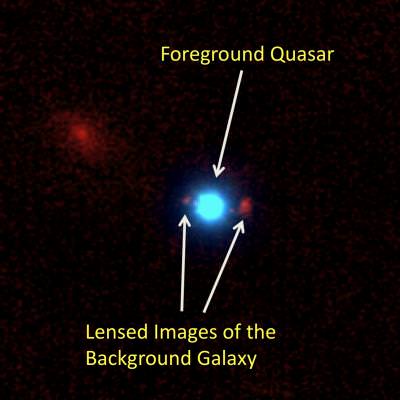
[/caption]
Gravitation lensing – a phenomenon that falls out of Einstein’s theory of general relativity – has been observed numerous times, making for some fantastic images of rings, arcs and crosses composed of massive galaxies light years away. As the light from a background object is bent by gravity around a foreground object, multiple, magnified images of the background object are produced from our vantage point.
For the first time, a quasar (quasi-stellar object) has been shown to gravitationally lens a galaxy behind it. About a hundred instances of gravitational lenses that consist of a foreground galaxy and a background quasar have been found, but this is the very first time where the opposite is the case; that is, a quasar bending the light from a background galaxy around it to create a multiple image of that galaxy.
Quasars are thought to be the result of a supermassive black hole at the center of a galaxy attempting to swallow up all of the matter that surrounds it. As the matter bunches up when it gets closer to the black hole, it heats up due to friction and begins to emit light across the electromagnetic spectrum. The light from a quasar can outshine an entire galaxy of stars, making it difficult to separate the light from a background galaxy from the overwhelming glare of the quasar itself.
To make this initial detection (there are surely many to follow), astronomers from the EPFL’s Laboratory of Astrophysics in cooperation with Caltech used data from the Sloan Digital Sky Survey (SDSS). They analyzed 22,298 quasars from the SDSS Data Release 7 catalog, and looked for images that had a strongly redshifted emission spectra. According to the paper announcing the results, “In these spectra, we look for emission lines redshifted beyond the redshift of the [quasar].”
In other words, a quasar that is lensing a galaxy in the background will exhibit a higher redshift than one that is not lensing a background galaxy, since the light from the galaxy and the quasar are combined in the SDSS data. So, quasars that had an expected redshift were thrown out, and a statistical analysis of quasars with emission lines that might mimic a gravitational lens eliminated many more of the objects. This left about 14 objects of the 22,298 analyzed as potential candidates. Of these 14, the team selected one to perform follow-up observations on, named SDSS J0013+1523.
SDSS J0013+1523 lies about 1.6 billion light years away, and is lensing a galaxy that is about 7.5 billion light years away from Earth. Using the Keck II telescope, they were able to confirm that SDSS J0013+1523 was indeed lensing the light from a galaxy located behind it. Hubble images of the discovery are in the works.
Here’s a video produced by the EPFL describing the results.
What is significant about this discovery – besides the novel aspect of a quasar acting as a lens – is that it will allow researchers to better refine their understanding of quasars. When light is bent around an object, it bends because of gravity, and gravity is a result of mass. So, something that is very massive will act as a stronger lens than something that is tiny, and the mass of the object doing all of the lensing work – in this case, the foreground quasar – can be determined.
Their results were published in a letter to Astronomy & Astrophysics on July 16th. The original paper is available for your perusal here.
WISE Mission Completes All-sky Infrared Survey
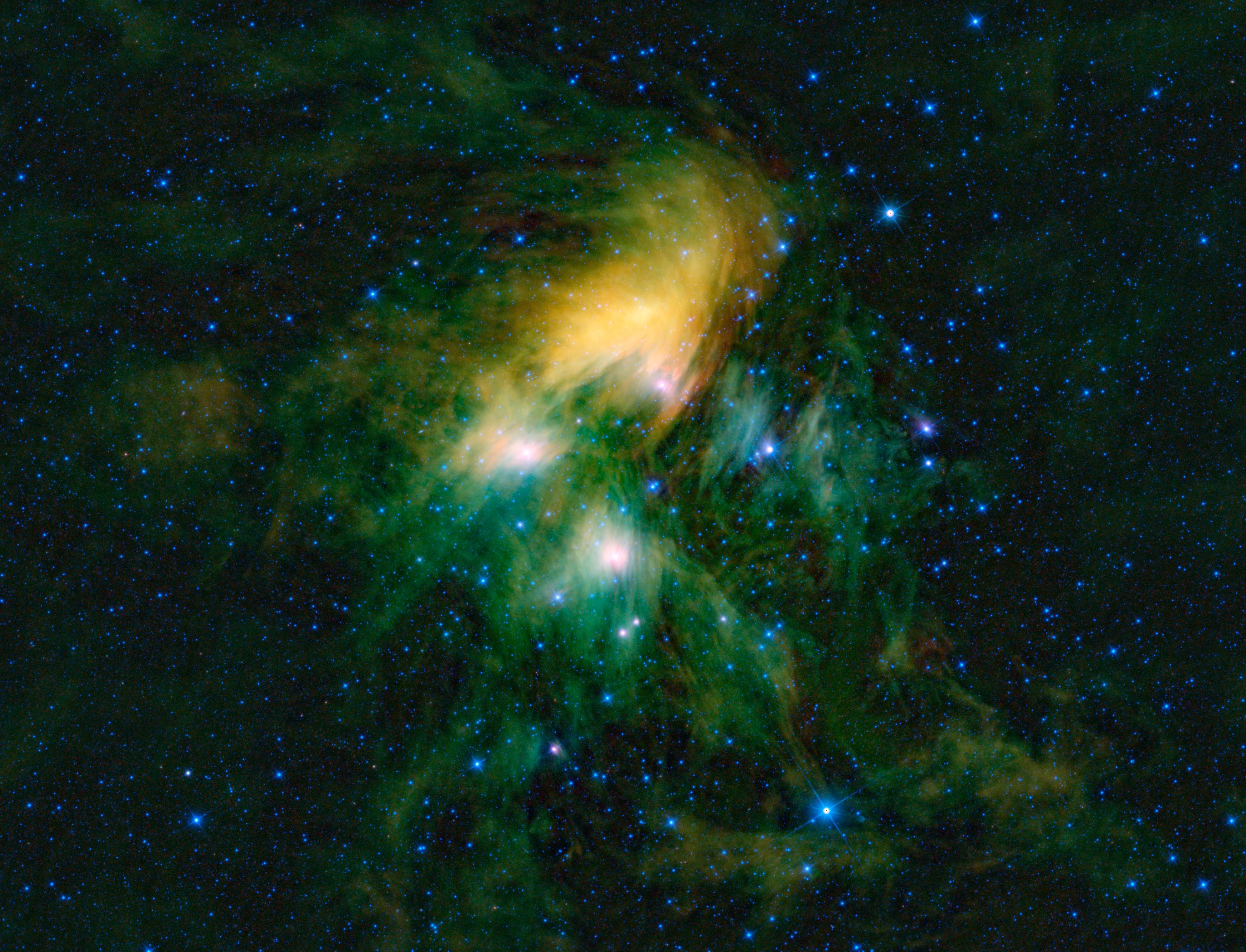
[/caption]
If you take a lot of digital pictures, you’re probably familiar with the frustration of keeping track of dozens of files, and always running out of hard drive space to store them. Well, the scientists and engineers on NASA’s Wide-field Infrared Survey Explorer (WISE) mission have no pity for you. Their spacecraft just finished photographing the entire sky in exquisite detail: a total of 1.3 million photos.
“The eyes of WISE have not blinked since launch,” said William Irace, the mission’s project manager at NASA’s Jet Propulsion Laboratory in Pasadena, Calif. “Both our telescope and spacecraft have performed flawlessly and have imaged every corner of our universe, just as we planned.”
WISE surveys the sky in strips as it orbits the earth. It takes six months of constant observing to map the entire sky. By pointing at every part of the sky, astronomical surveys deliver excellent data covering both well-known objects and those that have never been seen before.
“WISE is filling in the blanks on the infrared properties of everything in the universe from nearby asteroids to distant quasars,” said Peter Eisenhardt of JPL, project scientist for WISE. “But the most exciting discoveries may well be objects we haven’t yet imagined exist.”
One example of a well-known object seen in new light by WISE is the Pleiades cluster: a group of young blue stars shrouded by dust that the cluster is currently passing through. In WISE’s false-color infrared vision, the hot stars look blue but the cooler dust clouds give off longer wavelengths of infrared light, causing them to glow in shades of yellow and green.
The WISE survey is particularly significant because such a wide range of objects in the universe are visible in infrared light. Giant molecular clouds glow in infrared light, as do brown dwarfs – objects that are bigger than planets but smaller than true stars. WISE can also see ultra-bright, extremely distant galaxies whose visible light has been stretched into the infrared by the expansion of the universe during its multi-billion-year journey.
The recently completed WISE survey also observed 100,000 asteroids in our solar system, many of which had never been seen before. 90 of the newly discovered asteroids are near-earth objects, whose orbits cross our own, making them potentially dangerous but also potential targets for future mission.
You might think that 1.3 million pictures would be plenty, but WISE will keep mapping the sky for another three months, covering half of the sky again and allowing astronomers to search for changes. The mission will end when the spacecraft’s solid hydrogen coolant finally runs out and the infrared detectors warm up (they don’t work as well when they are warm enough to emit the same wavelengths of infrared light that they are meant to detect).
But even as the telescope warms up, the astronomers on the WISE team will just be getting warmed up too. With nearly two million images, they will be busy making new discoveries for years to come.
Lunar Forums and Anniversaries
[/caption]
I’m attending the NASA Lunar Science Institute’s Lunar Forum at Ames Research Center in California, which will feature sessions on recent scientific results as well as talks on future opportunities for lunar science, education and outreach. Notably, there will be new results from the Lunar Reconnaissance Orbiter, LCROSS and more. If you’d like to know more about the Forum, I did a 365 Days of Astronomy podcast for NLSI to preview some of the highlights of the Forum, and talked with with Greg Schmidt, the Deputy Director of the NASA Lunar Science Institute, and Doris Daou, the Institute’s Director for Education and Public Outreach.
Click here to download the podcast (or listen on the little embedded player at the bottom of this post).
Or see the 365 Days of Astronomy webpage here.
I’ll try to report as much news as I can, although my real mission here is to interview the lunar scientists for more NLSI/365 Days podcasts.
It’s fitting that the Lunar Forum is held this week: Forty-one years ago today, one of the most important events in American history unfolded on the surface of the Moon as the Apollo 11 lunar module, the Eagle, settled down on the landing site, Mare Tranquillitatis (Sea of Tranquility) at 00.67408 °N latitude, 23.47297 °E longitude. That’s an image of the Apollo 11 landing site above, as seen by LRO. So, happy Giant Leap Day!
Best Reality TV Ever: Camera Will Take Video of Next Mars Rover Landing
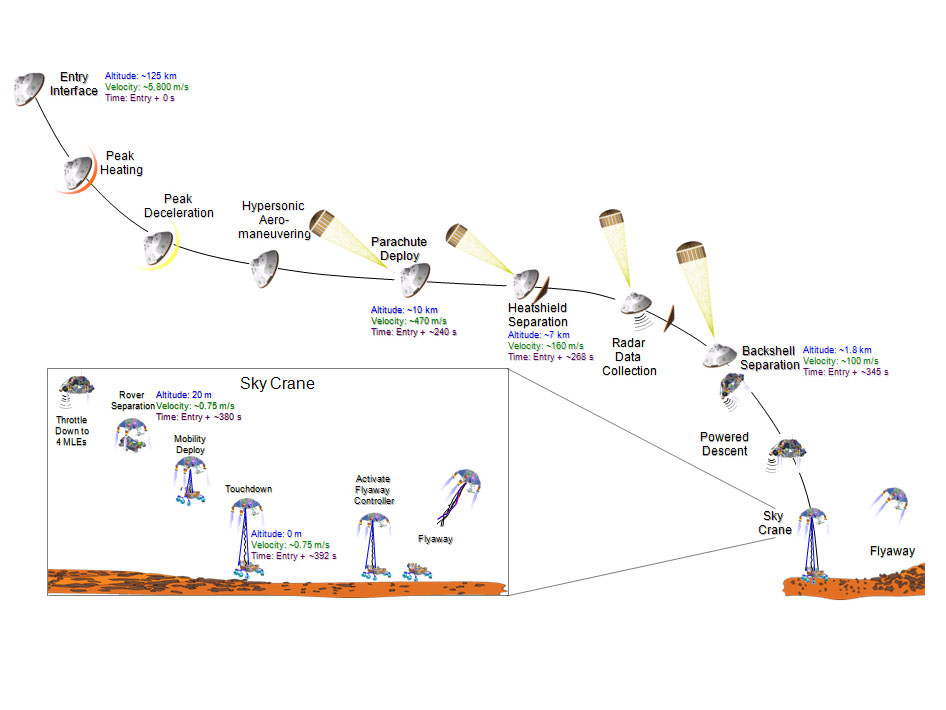
[/caption]
Now THIS is what I call “must-see TV!” A camera on the next Mars Rover — MSL, also known as Curiosity – will start recording high-definition video about two minutes before the rover lands on Mars, currently scheduled for August 2012. The Mars Descent Imager, or MARDI, will provide all of us Martian-wannabes with the first-ever ride along with the landing — and this will be a very unique landing, with the “Sky –Crane” lowering Curiosity to the planet’s surface. The video won’t be live, however – that’s way too much data for the spacecraft to send back to Earth at such an important event, but we will get to see it later. JPL provided a description of what the video should look like:
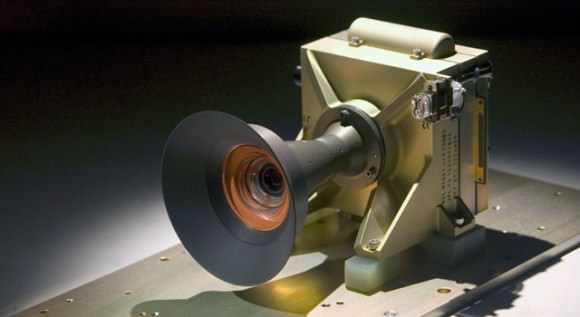
MARDI will start recording high-resolution video about two minutes before landing in August 2012. Initial frames will glimpse the heat shield falling away from beneath the rover, revealing a swath of Martian terrain below illuminated in afternoon sunlight. The first scenes will cover ground several kilometers (a few miles) across. Successive images will close in and cover a smaller area each second.
The full-color video will likely spin, then shake, as the Mars Science Laboratory mission’s parachute, then its rocket-powered backpack, slow the rover’s descent. The left-front wheel will pop into view when Curiosity extends its mobility and landing gear.
The spacecraft’s own shadow, unnoticeable at first, will grow in size and slide westward across the ground. The shadow and rover will meet at a place that, in the final moments, becomes the only patch of ground visible, about the size of a bath towel and underneath the rover.
Dust kicked up by the rocket engines during landing may swirl as the video ends and Curiosity’s surface mission can begin.
All of this, recorded at about four frames per second and close to 1,600 by 1,200 pixels per frame, will be stored safely into the Mars Descent Imager’s own flash memory during the landing. But the camera’s principal investigator, Michael Malin of Malin Space Science Systems, San Diego, and everyone else will need to be patient. Curiosity will be about 250 million kilometers (about 150 million miles) from Earth at that point. It will send images and other data to Earth via relay by one or two Mars orbiters, so the daily data volume will be limited by the amount of time the orbiters are overhead each day.
“We will get it down in stages,” said Malin. “First we’ll have thumbnails of the descent images, with only a few frames at full scale.”
Subsequent downlinks will deliver additional frames, selected based on what the thumbnail versions show. The early images will begin to fulfill this instrument’s scientific functions. “I am really looking forward to seeing this movie. We have been preparing for it a long time,” Malin said. The lower-resolution version from thumbnail images will be comparable to a YouTube video in image quality. The high-definition version will not be available until the full set of images can be transmitted to Earth, which could take weeks, or even months, sharing priority with data from other instruments.”

